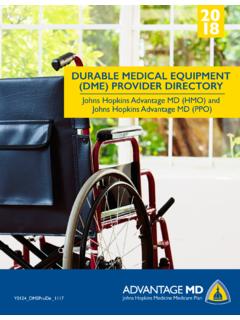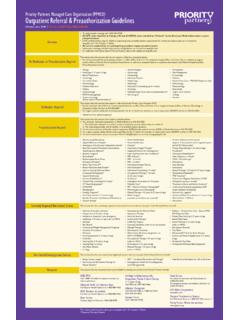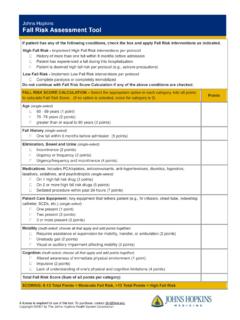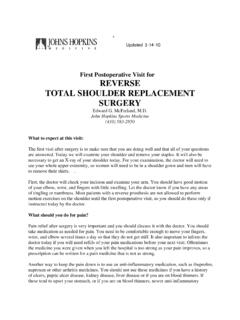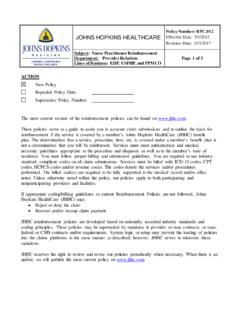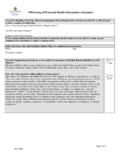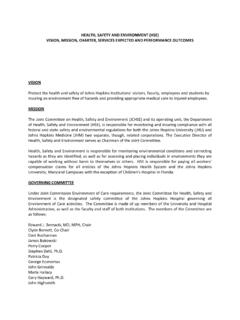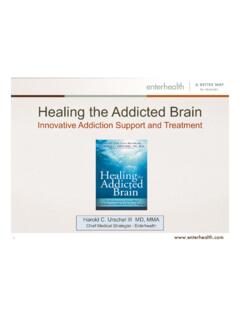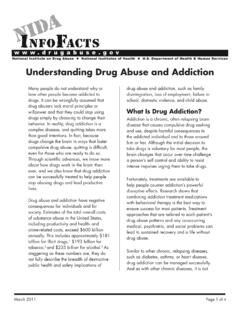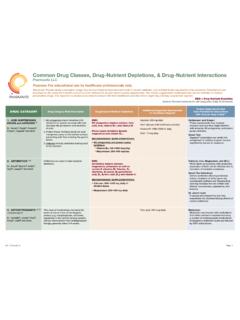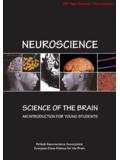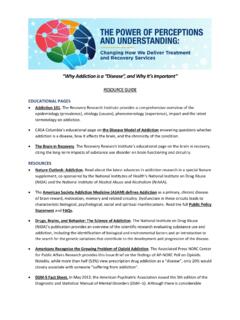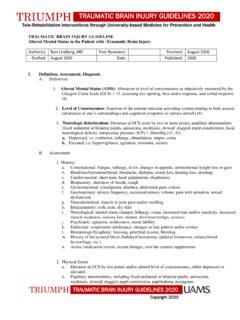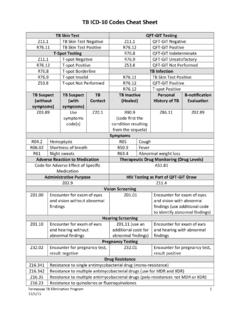Transcription of ELECTROCONVULSIVE THERAPY TODAY - Hopkins Medicine
1 ELECTROCONVULSIVETHERAPYTODAYI rving M. Reti, ,is the director of the ELECTROCONVULSIVE THERAPY Service at TheJohns Hopkins Hospital and an assistant professor in the Department of Psychiatry andBehavioral Sciences at The Johns Hopkins University School of Medicine . He has receivednumerous honors in his distinguished career, including The Johns Hopkins UniversitySchool of Medicine Clinician Scientist Award, and his research work is funded by theNational Institutes of Health. His research papers have been published in such medicaljournals asNeuropsychopharmacology, the Journal of Neurochemistry, and theEuropean Journal of Reti hails from Sydney, Australia, where he earned his (Bachelor of Medicineand Bachelor of Surgery the equivalent of an in the United States).
2 He moved tothe United States to do his psychiatry residency at Johns Hopkins and served as chiefresident. ELECTROCONVULSIVE THERAPY (ECT) is hands-down the most controversial treat-ment in modern psychiatry. No other treatment has generated such a fierce andpolarized public debate. Critics of ECT say it s a crude tool of psychiatric coercion;advocates say it is the most effective, lifesaving psychiatric treatment that truth is that modern-day ECT is a far cry from the old methods that earnedECT its sinister reputation. For many of you reading this, the thought of ECTconjures up images of the 1975 movie One Flew Over the Cuckoo s Nest, withJack Nicholson thrashing about, forced against his will to endure painful, violentseizures.
3 This is not an accurate portrayal of how ECT is used TODAY . The treat-ment has evolved into a relatively painless procedure with proven effectivenessin the fight against depression. It has survived its critics because it is safe andbecause it , much of the opposition to ECT seems political in nature and originatesin the anti-psychiatry groups that even oppose the use of antidepressants for thetreatment of depression. These groups inaccurately perceive ECT as invasive andbrain damaging and insist that no reasonable person can give an informedconsent for such a treatment.
4 Attacks on ECT continue to be featured on theInternet, on television and radio talk shows, and in newspaper articles. Thesefuel the public s fears and misperceptions regarding the psychiatrists, there is little controversy about ECT. The National Institute22IN-DEPTHREPORTof Mental Health, the American Psychiatric Association, the American MedicalAssociation, and the Surgeon General all endorse ECT as a valuable tool inthe treatment of certain psychiatric disorders, including depression. ECT involves passing a carefully controlled electrical current through a person sbrain to trigger a seizure a rapid discharge of nerve impulses throughout thebrain.
5 The electricity is passed between two electrodes that are placed on thepatient s scalp. Depending on the location of the electrodes, ECT is defined as bilateral or uni-lateral. In bilateral ECT, one electrode is placed on the left side of the head, theother on the right side. In unilateral ECT, one electrode is placed at the top(vertex) of the head and the other typically on the right side. (The differencesbetween bilateral and unilateral ECT are discussed further on page 29.) Whenthe current is passed between the electrodes, a generalized seizure is producedin the brain .
6 The seizure usually lasts for 30 to 60 is sometimes referred to as shock THERAPY , but this is a misnomer. People whoundergo ECT TODAY feel no electric shock because they are unconscious duringthe procedure. A better termfor ECT is seizure THERAPY , because the effect of23 ELECTROCONVULSIVE THERAPY TodayTHE HISTORY OF ELECTROCONVULSIVE THERAPYECT was first used in the 1930s. At first, researchers injected chemicals inpeople with mental disorders to induce seizures, but the chemicals weresoon replaced by electrical currents. Because of ECT s obvious effectiveness and the lack of alternate treatments,it was used widely in the decades preceding the introduction of antidepres-sant medications in the 1950s.
7 In those early years, ECT was administeredwithout anesthesia or muscle relaxants, and the electrical current was muchhigher than what is used TODAY . The THERAPY could therefore be painful andrisky. Violent seizures would cause the body to thrash with a force greatenough to break is very different TODAY , although it does still pose a risk of side effects,such as confusion and memory loss. The THERAPY is far more refined, withcarefully calculated electrical currents administered in a controlled medicalsetting to achieve maximum benefits with minimal risks. IN-DEPTHREPORTthe electrical current is to induce a generalized seizure.
8 Even the term electro-convulsiveis misleading, given that drugs are used to suppress the convulsions(powerful involuntary muscle contractions) that typically accompany a seizure. Regardless of its name, the bottom line is that ECT is far and away the mosteffective treatment that currently exists for depression. The recent resurgenceof interest in the procedure is therefore not surprising. Depression is such a pervasive problem, and the medications available TODAY donot come anywhere close to ECT in terms of effectiveness. Doctors who performECT essentially treat people who are medication resistant or who have suboptimalresponses to the medicines, and about 85% of these difficult-to-treat patientsimprove with ECT.
9 This is a remarkably high response rate in a severelydepressed group of people. Moreover, the rapid response most patients have to ECT sometimes as fast asafter the first or second treatment makes it incredibly valuable. There aremany situations where this is necessary. When a patient is suicidal, for example,you can t wait around for several weeks while a drug takes effect. ECT is there-fore often the first-line treatment in an emergency, especially when a person issuicidal, psychotic, not eating, or catatonic (immobile).Some 100,000 Americans undergo ECT treatments each year.
10 Deciding whetherECT is a good treatment option for you or a loved one and whether it shouldbe your first-line treatment or your last resort can be a difficult decision. The following are questions I m frequently asked by patients and physiciansabout ECT. The answers should help you make an informed decision about thetreatment. Q. When is ECT an appropriate treatment?A. ECT is generally recommended for people with severe depression (accom-panied by psychosis, suicidal intent, or refusal to eat), especially if it is resistantto medications. It is also used for mania that has not improved with medica-tions and for schizophrenia (when symptoms are severe or medications areinadequate).
